In this article
If you’re searching for the best trekking in europe, you’ve likely been flooded with stunning photos of jagged peaks and idyllic alpine villages. But a postcard image doesn’t tell you how to navigate a glacial river crossing or what “hut etiquette” even means. This hiking guide is different. We move beyond simple lists to empower you with the knowledge and skills needed to confidently choose, plan, and conquer Europe’s most legendary multi-day hikes. Here, you will discover a curated list of epic hiking itineraries, from the iconic Alps to the volcanic landscapes of Iceland. You will learn to choose the right hike for you with our unique three-dimensional difficulty framework and gain the confidence to tackle challenging terrain with embedded mini-guides on essential skills. Most importantly, you will understand how to travel responsibly, with trail-specific guidance that respects the landscapes and cultures you explore.
Beyond the Postcard: How to Choose Your Perfect European Trek
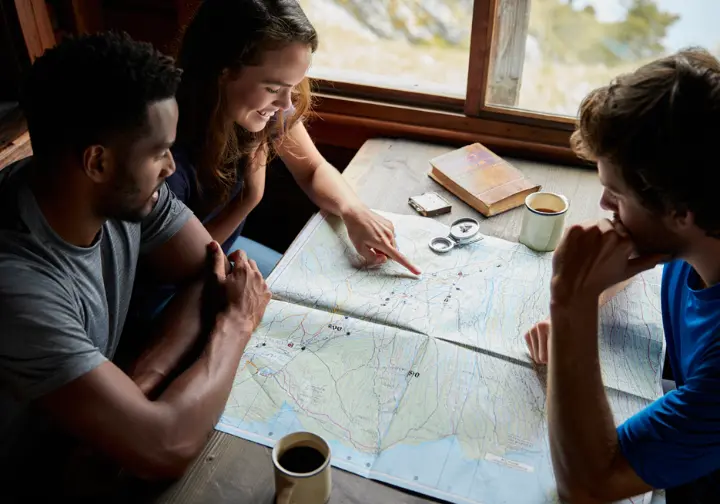
Choosing the right multi-day hiking trail can be overwhelming. The sheer number of incredible options, from the sun-drenched coasts of Northern Portugal to the arctic trails of Sweden, can lead to decision paralysis. This section provides a strategic framework to help you move past that and select the perfect trail that matches your personal hiking style, fitness level, and appetite for adventure.
Deconstructing ‘Difficulty’: Our 3D Assessment Model
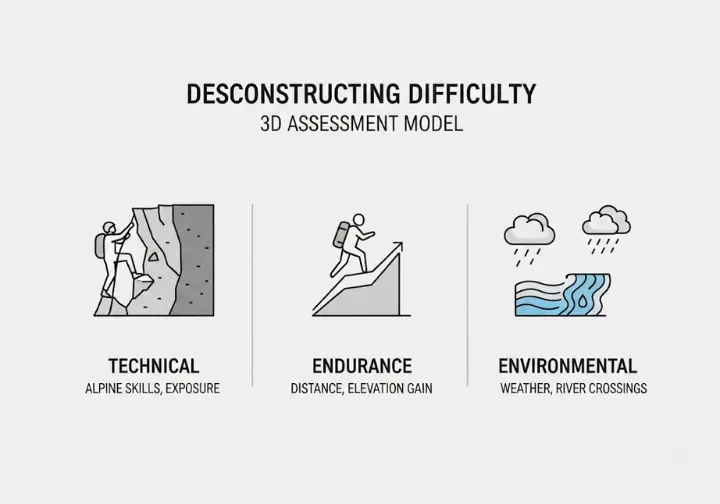
Most guides use vague terms like “moderate” or “hard,” which fails to capture the true nature of a trail’s challenge. To solve this, we assess difficulty across three distinct dimensions: Technical, Endurance, and Environmental. This system helps you understand why a particular hike is difficult and if its specific challenges align with your personal strengths. The Technical dimension rates the need for specific alpine skills and comfort with exposure, such as scrambling on the GR20 or using via ferrata equipment in the Dolomites. A low technical rating implies a straightforward walking path, while a high rating demands confident footwork and a head for heights on more technical terrain.
The Endurance dimension measures the physical stamina required, based on daily distance and total elevation gain. A long-distance trail like the full Slovenian Mountain Trail has a very high endurance rating due to its sheer length, while a shorter but steeper trek might have a lower overall endurance score but require higher daily intensity. Finally, the Environmental dimension considers challenges posed by the landscape itself, such as unbridged river crossings in Iceland or the risk of unpredictable weather and high altitude in the alpine zone. This allows you to prepare for objective hazards beyond just the trail’s physical demands, like those found within the diverse landscapes of Triglav National Park.
Matching a Trek to Your Style: Hut, Hotel, or Tent?
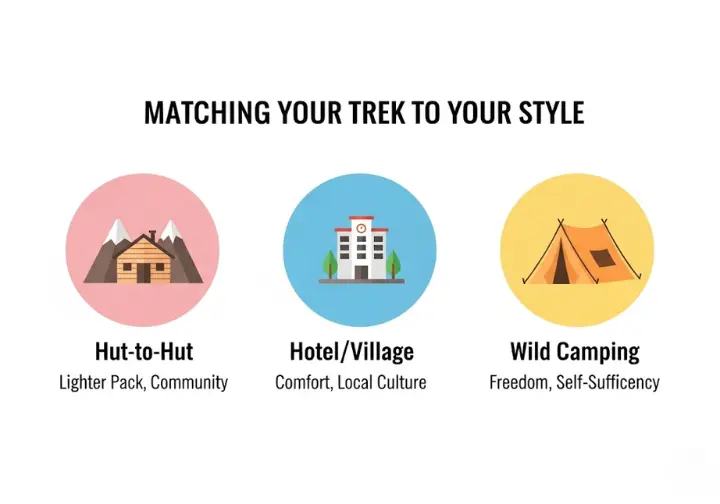
The style of accommodation profoundly shapes your trekking experience, your budget, and most critically, your pack weight. The classic European “hut-to-hut” style involves hiking between mountain refuges (rifugi, gîtes, hytter), which offer dormitory-style lodging and often hearty meals. This system allows for a lighter backpack and fosters a strong sense of community among fellow hikers. For those seeking more comfort, a “village-to-village” or hotel-based trek is an excellent option, particularly on routes like the Camino de Santiago or along the rules for the West Highland Way. This style allows you to enjoy local culture and cuisine but often involves more complex logistical planning, whether on a self-guided trip or one of the many fully-guided trips available.
Wild camping offers the most freedom but is subject to strict regulations that vary significantly by country. While permitted in places like Scotland and parts of Scandinavia—where organizations like the Norwegian Trekking Association manage hut systems—it’s largely forbidden in the high alpine environments of the Alps. This makes it a style best suited for specific hiking trails and the experienced hiker prepared for self-sufficiency by choosing the right trekking tent.
The Best Multi-Day Treks in Europe: A Definitive Guide
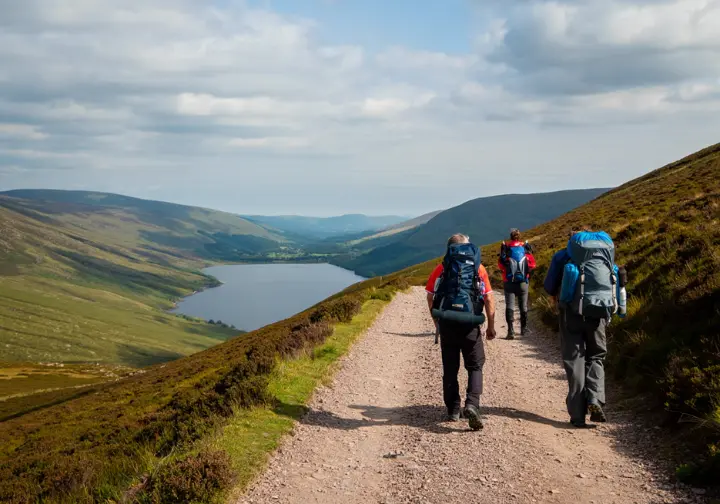
Here are our definitive selections for Europe’s most epic hike itineraries. Each profile in this full hike guide goes beyond a simple description to provide key statistics, highlights, and the actionable intelligence you need to start planning. Below are four of our top 15 selections for your next memorable trip, covering the essential strategies and skills required for each.
1. Tour du Mont Blanc (TMB) – France, Italy, Switzerland
The TMB is arguably the world’s most famous thru-hike, a classic hike circumnavigating the stunning Mont Blanc massif through three different countries—including France—in a 10-12 day journey. Hikers are treated to a daily spectacle of glaciers, charming alpine villages, and dramatic mountain passes. Covering approximately 170 kilometers (105 miles) with around 10,000 meters (32,800 feet) of elevation gain, its popularity means logistics are critical. Many adventurers tackle its well-maintained paths in sturdy backpacking trail runners.
- Accommodation Strategy: The TMB has a highly developed network of refuges (refugios, gîtes), but booking is absolutely essential and highly competitive, often requiring reservations 6-9 months in advance. Utilize official booking portals for the Tour du Mont Blanc and this welcome and information website to plan, and be aware of “chokepoint” huts that fill up fastest.
- Responsible Trekker Mandate: The immense popularity of the TMB puts significant pressure on the local environment. It is critical to stay on marked trails to prevent erosion, pack out all trash including food waste, and respect the regulations that prohibit wild camping along most of the entire hiking trail to protect the fragile alpine ecosystem.
2. Alta Via 1 (AV1) – Dolomites, Italy
The Alta Via 1 is a breathtaking journey through the heart of the Italian Dolomites, a UNESCO World Heritage site known for its pale, jagged peaks and fascinating World War I history. This 120 km (75-mile) trek is less technically demanding than its counterpart, the AV2, making it an excellent introduction to trekking in the region. The route takes about 10 days and features dramatic passes and stays in charming Italian rifugi, demanding durable walking boots for women and men alike to handle the rocky terrain.
- Required Skills Mini-Guide (Via Ferrata): While the AV1 is mostly a walking trail, it features optional protected sections and a famous WWI tunnel system near Rifugio Lagazuoi that may involve basic via ferrata (“iron path”) techniques. This involves clipping into a steel cable for safety. A helmet is essential, and for the less experienced, a proper via ferrata kit (harness, lanyard, carabiners) provides necessary security.
- Accommodation Strategy: Booking the rifugi on the AV1 is a major logistical challenge and must be done many months in advance, as there is no central booking system. You will need to contact each hut individually via email or their website. Flexibility with your itinerary is key to securing spots.
3. Laugavegur Trail – Iceland
The 55 km (34-mile) Laugavegur Trail is Iceland’s most famous hiking trail, offering an otherworldly landscape of rainbow-colored rhyolite mountains, black volcanic deserts, glaciers, and geothermal hot springs. Typically completed in 4 days, this multi-day hike presents unique environmental challenges that require specific skills and preparation.
- Required Skills Mini-Guide (River Crossing): The famous Laugavegur hike features several unbridged and potentially fast-flowing glacial river crossings. It is critical to have dedicated river crossing shoes (do not hike barefoot) and use essential trekking poles for backpacking for stability. Face upstream, move slowly, and know how to link arms with others for a group crossing. Never attempt to cross during high water levels or if you feel unsafe.
- Responsible Trekker Mandate: The Icelandic ecosystem is incredibly fragile. Stay strictly on the marked path to avoid damaging delicate moss and cryptobiotic soil that can take decades to recover. Wild camping is forbidden; you must stay in the designated huts or associated campgrounds, which require advance booking.
4. GR20 – Corsica, France
Often cited as Europe’s toughest long distance hiking trail, the GR20 is a rugged, 180 km (112-mile) traverse of the granite mountains of Corsica. This strenuous hike is a serious undertaking, demanding exceptional fitness from any serious hiker, a head for heights, and experience with steep, technical scrambling over its 15-day duration. The rewards are unparalleled views and a massive sense of accomplishment for those who love the challenge of Grandes Randonnées (GR).
- Required Skills Mini-Guide (Scrambling): The GR20 is defined by its frequent sections of Class 2 and 3 scrambling, where you will need to use your hands for balance and upward progress. Our guide to Class 2 and 3 terrain can help you prepare. On the trail, maintaining three points of contact, testing handholds and footholds before committing your weight, and being comfortable with significant exposure are essential skills for a safe journey.
- Accommodation Strategy: The GR20 is serviced by a system of basic refuges run by the Parc Naturel Régional de Corse. Booking these refuges in advance is mandatory. You can also opt to rent a tent at the refuge or carry your own, but you must still camp at the designated sites.
The Hiker’s Toolkit: Essential Skills, Gear & Planning for Europe
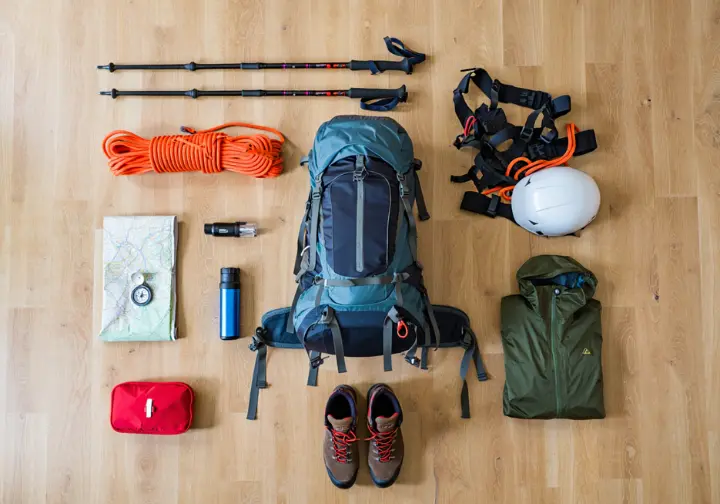
A successful European trek depends on more than just physical fitness; it requires the right skills, gear like sturdy hiking shoes, and preparation. This section is your masterclass in becoming a competent and confident trekker, covering everything from navigation to budgeting and trail etiquette.
Mastering Navigation: From Digital Tools to Analog Backup
While many European walking trails are well-marked, you should never rely solely on trail signage. Mastering navigation is a core skill for safety and self-reliance, and it involves using a combination of digital and analog tools to always know your location. Modern GPS apps on your smartphone are powerful tools for real-time tracking, but you must download offline maps for your chosen region before you lose service. Always carry a power bank to ensure your device remains charged throughout your long distance trip.
A physical map and a compass are your non-negotiable, battery-free backups. Before your trip, you should practice basic skills like orienting the map to your surroundings and understanding how contour lines represent the terrain’s steepness. This is the analog skillset that will keep you safe if your electronics fail, a vital tool when visiting the Picos de Europa National Park or any other remote range. By committing to mastering analog navigation skills, you become truly self-sufficient.
The Responsible Trekker Mandate: Leave No Trace & Local Etiquette
Being a responsible trekker goes beyond the universal principles of Leave No Trace; it involves understanding and respecting the specific ecological and cultural contexts of the region you are visiting. This demonstrates a deeper level of stewardship for the places we love to explore. In fragile environments like the high Alps or coastal dunes, it is critical to stay on the trail, pack out everything (including organic waste like fruit peels), and observe wildlife from a distance. In areas with a strong agricultural presence, always leave gates as you find them and do not disturb livestock.
Cultural pilgrimage routes have their own unique etiquette. For those walking the Camino de Santiago, respecting the traditions of each pilgrim and greeting others with a “Buen Camino” is part of the pilgrimage experience, as detailed on the official Camino de Santiago website. When staying in mountain huts, it’s customary to be quiet during evening hours, keep your gear organized, and follow the specific rules of the hut keeper. Our guide to Leave No Trace offers a solid foundation for these practices.
Conclusion: Your Adventure Awaits
Choosing an epic hike in Europe is about finding the perfect intersection of stunning mountain landscapes and personal challenge. By moving beyond vague difficulty ratings and understanding a trail’s technical, endurance, and environmental demands, you can make a truly informed decision. True confidence on the trail comes from empowerment—mastering the specific skills, logistics, and responsible practices required for your chosen adventure. This guide has provided the framework and the tools; the next step is to start planning your journey from dream to trailhead.
What European trek is at the top of your list? Share your dream destination in the comments below and join the conversation!
Frequently Asked Questions about Trekking in Europe
What is the most beautiful multi-day hike in Europe?
“Beauty” is subjective and depends on your preferred landscape. For classic, dramatic alpine scenery with glaciers and jagged peaks, the Tour du Mont Blanc is a world-class choice. For unique volcanic landscapes with rainbow-colored mountains, Iceland’s Laugavegur Trail is considered one of the most uniquely beautiful hikes on earth.
Where is the best trekking in Europe for beginners?
Scotland’s West Highland Way is an excellent choice for beginners. It features well-maintained, low-altitude paths, clear waymarking, and plentiful accommodation in villages along the route, which simplifies logistics. Portugal’s Rota Vicentina (Fisherman’s Trail) is another great option, offering stunning coastal trail scenery without significant elevation gain.
How do I book the mountain huts for popular treks like the TMB or Alta Via 1?
Booking mountain huts is a major logistical step that must be done months in advance. For the TMB, there are official booking portals that manage many huts. For the Alta Via 1 and other destinations, there is no central system; you must contact each hut individually.
What is the best season for trekking in the Alps?
The main trekking season in the Alps is short, running from late June to mid-September. This is when trails are most likely to be snow-free and huts are open. Hiking outside this window carries a significant risk of encountering dangerous snow and ice on high passes.
Risk Disclaimer: Hiking, trekking, backpacking, and all related outdoor activities involve inherent risks which may result in serious injury, illness, or death. The information provided on The Hiking Tribe is for educational and informational purposes only. While we strive for accuracy, information on trails, gear, techniques, and safety is not a substitute for your own best judgment and thorough preparation. Trail conditions, weather, and other environmental factors change rapidly and may differ from what is described on this site. Always check with official sources like park services for the most current alerts and conditions. Never undertake a hike beyond your abilities and always be prepared for the unexpected. By using this website, you agree that you are solely responsible for your own safety. Any reliance you place on our content is strictly at your own risk, and you assume all liability for your actions and decisions in the outdoors. The Hiking Tribe and its authors will not be held liable for any injury, damage, or loss sustained in connection with the use of the information herein.
Affiliate Disclosure: We are a participant in the Amazon Services LLC Associates Program, an affiliate advertising program designed to provide a means for us to earn advertising fees by advertising and linking to Amazon.com. As an Amazon Associate, we earn from qualifying purchases. We also participate in other affiliate programs and may receive a commission on products purchased through our links, at no extra cost to you. Additional terms are found in the terms of service.











